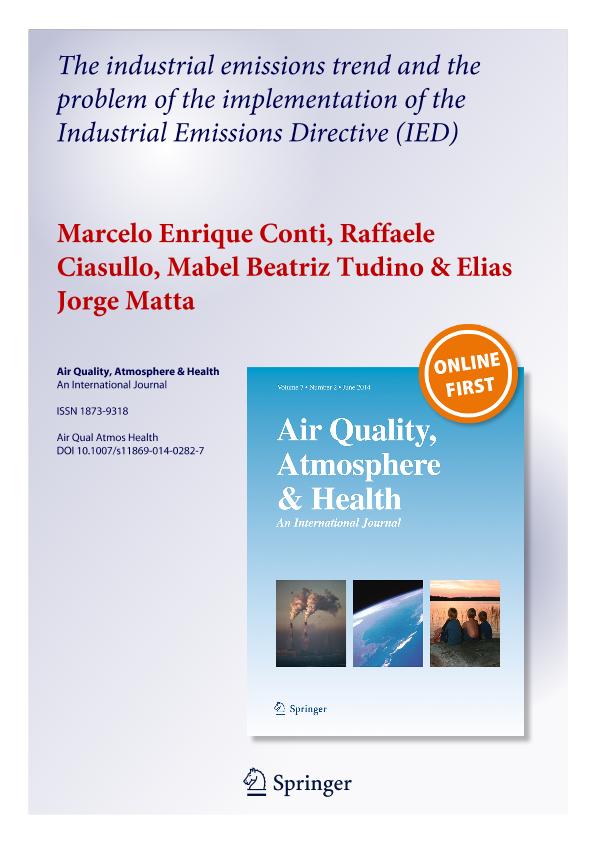Mostrar el registro sencillo del ítem
dc.contributor.author
Conti, Marcelo Enrique
dc.contributor.author
Ciasullo, Raffaele
dc.contributor.author
Tudino, Mabel Beatriz

dc.contributor.author
Matta, Elias Jorge

dc.date.available
2018-09-10T16:09:30Z
dc.date.issued
2015-04
dc.identifier.citation
Conti, Marcelo Enrique; Ciasullo, Raffaele; Tudino, Mabel Beatriz; Matta, Elias Jorge; The industrial emissions trend and the problem of the implementation of the Industrial Emissions Directive (IED); Kluwer Academic Publishers; Air Quality, Atmosphere and Health; 8; 2; 4-2015; 151-161
dc.identifier.issn
1873-9326
dc.identifier.uri
http://hdl.handle.net/11336/58879
dc.description.abstract
The European Integrated Pollution Prevention and Control (IPPC) came into force in 1996. In 2010, the EU Parliament approves the Industrial Emissions Directive (IED) that abrogates the IPPC directive. This directive lays down measures designed to regulate emissions arising from the activities of large European industries which recorded a constant decrease from 1990 to 2011. This trend refers especially to SOx/SO2 partly because of some technical changes such as the use of natural gas in the 1990s instead of coal and lignite. We can state that the 2008–2009 crisis is the most serious, affecting not only production but also other key economic sectors such as energy consumption. The aim of this work is to discuss relevant topics such as the current situation of industrial emissions in Europe and the trend of the industrial emissions since the promulgation of the directive. We also discuss the directive’s main application tools which are the best available techniques reference documents and the best available techniques that show some weakness. For instance, the “concentration approach” for measuring emissions does not comply with the environment and health problems, because it sets no limit to the production. We absolutely need to improve above mentioned tools if we want to reduce the emission of pollutants to acceptable levels, in spite of the European financial condition. The IPPC aimed at accelerating the reduction trend of the industrial emissions especially between 2000 and 2011. In conclusion, we still haven’t found evidences of significant results of its implementation as the emissions behaviour is also strongly influenced by the economy.
dc.format
application/pdf
dc.language.iso
eng
dc.publisher
Kluwer Academic Publishers
dc.rights
info:eu-repo/semantics/openAccess
dc.rights.uri
https://creativecommons.org/licenses/by-nc-sa/2.5/ar/
dc.subject
Bat
dc.subject
Bref
dc.subject
Directive Ied
dc.subject
Directive Ippc
dc.subject
Human Health
dc.subject
Industrial Emissions
dc.subject.classification
Meteorología y Ciencias Atmosféricas

dc.subject.classification
Ciencias de la Tierra y relacionadas con el Medio Ambiente

dc.subject.classification
CIENCIAS NATURALES Y EXACTAS

dc.title
The industrial emissions trend and the problem of the implementation of the Industrial Emissions Directive (IED)
dc.type
info:eu-repo/semantics/article
dc.type
info:ar-repo/semantics/artículo
dc.type
info:eu-repo/semantics/publishedVersion
dc.date.updated
2018-09-04T19:04:35Z
dc.journal.volume
8
dc.journal.number
2
dc.journal.pagination
151-161
dc.journal.pais
Países Bajos

dc.journal.ciudad
Dordretch
dc.description.fil
Fil: Conti, Marcelo Enrique. Università degli studi di Roma "La Sapienza"; Italia
dc.description.fil
Fil: Ciasullo, Raffaele. Università degli studi di Roma "La Sapienza"; Italia
dc.description.fil
Fil: Tudino, Mabel Beatriz. Consejo Nacional de Investigaciones Científicas y Técnicas; Argentina. Universidad de Buenos Aires. Facultad de Ciencias Exactas y Naturales. Departamento de Química Inorgánica, Analítica y Química Física; Argentina
dc.description.fil
Fil: Matta, Elias Jorge. Consejo Nacional de Investigaciones Científicas y Técnicas; Argentina. Universidad Nacional del Litoral. Facultad de Ingeniería Química. Instituto de Tecnología Celulósica; Argentina
dc.journal.title
Air Quality, Atmosphere and Health
dc.relation.alternativeid
info:eu-repo/semantics/altIdentifier/doi/https://dx.doi.org/10.1007/s11869-014-0282-7
dc.relation.alternativeid
info:eu-repo/semantics/altIdentifier/url/https://link.springer.com/article/10.1007/s11869-014-0282-7
Archivos asociados
